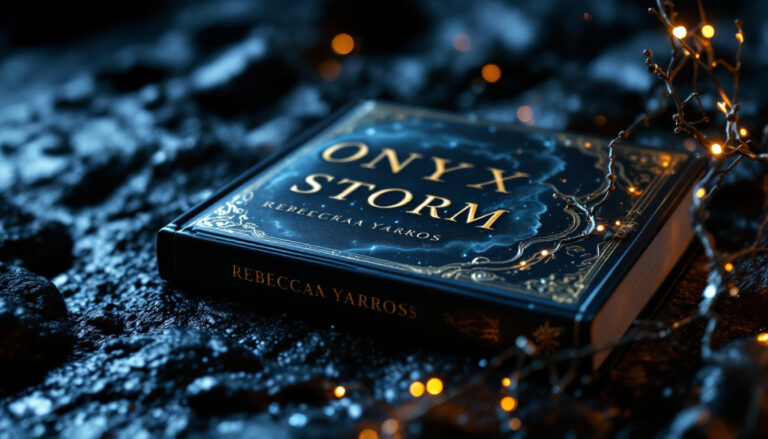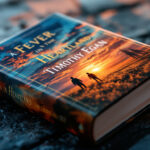Once Upon a Broken Heart by Stephanie Garber A Spellbinding Review
Stephanie Garber’s “Once Upon a Broken Heart” is a captivating blend of fantasy, romance, and mystery, set within the enchanting Caraval universe. This young adult novel introduces readers to Evangeline Fox, a hopeful, daring protagonist who makes a risky deal with the infamous Prince of Hearts. With its magical world, high-stakes decisions, and unforgettable characters, the story has drawn both loyal Caraval fans and new readers alike. Whether you’re familiar with Garber’s previous work or just dipping into fantasy for the first time, this book promises twists, emotional depth, and a touch of the unexpected.
Overview of ‘Once Upon a Broken Heart’
Stephanie Garber’s “Once Upon a Broken Heart” is a magical tale that dives into the complexities of love, sacrifice, and unexpected outcomes. The story sweeps readers into a richly detailed universe where emotions collide with ancient curses and destiny hangs by a thread.
Synopsis of the Story
The narrative centers around Evangeline Fox, a young woman fueled by heartbreak and determined to rewrite her fate. When her true love, Luc, becomes engaged to another, Evangeline takes an extraordinary step. She appeals to Jacks, the Prince of Hearts, an immortal with a dark reputation. In exchange for his help in halting the wedding, she agrees to his mysterious terms—making a deal that costs her more than she anticipates.
From this pact stems a cascade of complications. Evangeline finds herself entwined in a world of curses, shifting allegiances, and unforeseen consequences. The story deftly blends a classic fairytale-like structure with sharp twists that keep readers guessing about how far Evangeline is willing to go—and what Jacks really wants.
For readers who want a deeper look into the book’s synopsis and key points, this detailed review provides further insights.
Main Characters
- Evangeline Fox
The determined and romantic protagonist, Evangeline is willing to challenge destiny for love. She’s hopeful yet far from naïve. Her choices drive much of the conflict while revealing her resilience and capacity to grow in a world brimming with deception. - Jacks (The Prince of Hearts)
Jacks is the enigmatic and morally gray immortal at the heart of Evangeline’s woes. Equal parts charm and danger, his motives remain clouded in mystery, making him an irresistible force in the narrative. Readers are left questioning his true intentions—is he a villain, a hero, or something in between? Learn more about his complex character on Caraval Wiki. - Supporting Cast
In addition to Evangeline and Jacks, the story introduces a vivid array of characters. Figures like Luc and lesser immortals flesh out the universe, offering subplots and intrigue that add depth to the story’s tapestry.
Themes and Motifs
Garber weaves universal themes alongside unique motifs that elevate the story:
- Love and Betrayal: At its core, the book asks how far someone is willing to go for love, and whether the consequences of such sacrifices are worth it.
- Magic and Mystery: The world of “Once Upon a Broken Heart” is laced with enchantment, from cursed kisses to ancient spells. Each magical element serves as a metaphor for the unpredictability of life and emotions.
- Hope Amid Chaos: Despite heartbreak and hardship, Evangeline’s journey underscores the power of hope. Her unwavering belief in love—despite its pitfalls—is both inspiring and bittersweet.
- Recurring Motifs: Curses play a critical role, representing both punishment and the possibility of redemption. Destiny, too, looms large, with repeated questions about whether fate can be escaped or challenged. Curious to explore more about the series’ thematic depth? This article dives into these elements in greater detail.
This enchanting tale beckons readers to grapple with impossible choices while reveling in an immersive, magical setting. From Evangeline’s resolve to Jacks’ dangerous allure, “Once Upon a Broken Heart” is full of compelling elements that promise to leave readers hooked.
Writing Style and Narrative Tone
Stephanie Garber crafts her stories with a unique blend of whimsical creativity and emotional depth. In “Once Upon a Broken Heart,” her choices in world-building, point of view, and chapter structure all contribute to creating an enchanting and immersive reading experience.
World-Building in the North
The northern setting in “Once Upon a Broken Heart” is an integral part of its charm. Garber paints a vivid picture of a magical realm where every corner brims with enchantment. From snow-drenched landscapes to age-old castles that hold their own secrets, the North becomes a character in its own right.
Magical elements are delicately interwoven into the scenery, like enchanted forests that feel alive and shimmering skies that seem to react to the emotions of the characters. Garber doesn’t just describe the North—she invites readers to feel the crunch of snow beneath their feet and sense the ethereal hum of magic in the air.
This rich world-building adds layers to the story, making it easy for readers to lose themselves in a place that feels both fantastical and believable. For more analysis of Garber’s world-building, this review explores how her settings captivate readers.
Single POV Perspective
Garber uses a single point of view, focusing on Evangeline Fox. This choice allows readers to experience the story through her eyes. Evangeline’s perspective lends the narrative a personal and relatable touch, helping readers connect with her joys, fears, and desires.
Every magical encounter, every unexpected twist—Evangeline’s emotions and thoughts guide us through it all. It’s easy to root for her because we see her struggles firsthand. We feel her hope when she makes a deal with Jacks, her fear when things spiral out of control, and her determination to find her own happy ending.
This focused perspective ensures readers forge a strong bond with Evangeline while leaving other characters, like Jacks, shrouded in mystery. Want to dive deeper into her narrative style? Check out this article for more on Garber’s storytelling.
Use of Short Chapters
The short chapters in “Once Upon a Broken Heart” are a clever stylistic choice. They create a brisk pace that keeps the story moving and makes it difficult to put the book down. Short chapters often end with tantalizing cliffhangers that compel readers to dive into the next one.
This structure is particularly beneficial for young adult readers or people new to fantasy stories. It makes the book accessible and less intimidating, even as the plot grows more intricate. However, this fast-paced style can sometimes sacrifice moments of deeper reflection. Some readers might wish for more time to linger in the world or explore the characters’ inner lives.
That said, this approach underscores Garber’s emphasis on momentum and suspense. If you’re curious about how these techniques heighten readability, this review discusses it in greater detail.
Garber’s narrative craftsmanship shines through in every chapter of “Once Upon a Broken Heart.” Her balance of magical settings, intimate storytelling, and sharp pacing ensures an engaging and memorable journey for readers.
Characters and Their Relationships
The relationships in “Once Upon a Broken Heart” are some of the most intricate and compelling elements of the story. They drive the narrative forward, giving depth to the plot and emotional resonance to the characters’ decisions. From the electrifying interactions of Jacks and Evangeline to the morally ambiguous portrayals of secondary characters, Stephanie Garber weaves a web of connections that keeps readers captivated.
Jacks and Evangeline’s Dynamic
The relationship between Jacks, the enigmatic Prince of Hearts, and Evangeline Fox is as captivating as it is fraught with complications. Jacks, with his sharp charisma and unpredictable motives, immediately unsettles Evangeline, but their chemistry is undeniable. Their bond is built on a precarious foundation of manipulation and fragile trust, making every interaction between them a mix of tension and intrigue.
Jacks often appears self-serving, using others as pawns to achieve unclear goals. Yet, his moments of vulnerability hint at a deeper story, one that makes readers question his true intentions. Evangeline, on the other hand, is drawn to him despite understanding the risks. Her romantic idealism clashes with Jacks’ cynicism, creating a push-and-pull dynamic that’s as frustrating as it is irresistible.
One of the most fascinating aspects of their relationship is the question of trust. Can Jacks be relied upon, or is he simply biding his time until Evangeline no longer serves his purpose? Likewise, Evangeline’s willingness to believe in the good in people often leaves her vulnerable. Together, these two characters walk a fine line between mutual dependency and outright betrayal. For more insights into their complex dynamic, this character analysis takes a deeper dive.
Secondary Characters
Stephanie Garber’s ability to flesh out secondary characters adds richness to the narrative. These figures may not take center stage, but their presence leaves a lasting impression and plays a pivotal role in Evangeline’s journey. Key characters include:
- Luc: Evangeline’s first love, whose actions set much of the story in motion. His engagement to her stepsister, Marisol, drives Evangeline to strike her fateful bargain with Jacks.
- Marisol: While she seems like an innocent bystander at first, her role becomes more complicated as the story unfolds. Readers are left wondering whether her actions stem from malice or misunderstanding.
- Apollo: A prince who becomes entangled in Evangeline’s life in unexpected ways. His arc is both tragic and revealing, particularly as it showcases how fate and choices intertwine in Garber’s universe.
These secondary characters not only enrich the plot but also serve as mirrors for Evangeline. Through them, she learns about resilience, sacrifice, and the blurry lines between good and bad. If you’re curious about how these characters influence the story, this analysis offers a detailed breakdown.
Morally Grey Portrayals
One of the standout aspects of “Once Upon a Broken Heart” is Garber’s depiction of morally ambiguous characters. From Jacks’ manipulative tendencies to Apollo’s complex decisions, these portrayals make the story feel layered and authentic. No one is entirely a hero or a villain; instead, they exist in the messy in-between, driven by personal desires and complicated pasts.
For Jacks, his moral ambiguity fuels readers’ fascination. Is he a villain disguising himself as an antihero, or is there a spark of decency buried beneath his scheming exterior? Similarly, Marisol’s character is designed to provoke mixed emotions. She’s not entirely trustworthy, but her motivations seem rooted in her struggles rather than outright malice.
These morally grey characters not only make the story unpredictable but also force readers to confront their own assumptions. Garber skillfully reminds us that people—and Fates—are rarely as one-dimensional as they may seem at first glance. To explore more about how these characters deepen the narrative, check out this review.
By intricately weaving these character dynamics, Garber creates a story that keeps readers invested. Every action has consequences, every relationship is layered, and nothing is quite what it seems.
Strengths of ‘Once Upon a Broken Heart’
Stephanie Garber’s “Once Upon a Broken Heart” has enchanted readers with its creative magic, complex characters, and gripping plot twists. Let’s explore what makes this book a standout in modern fantasy.
Unique World-Building
The northern realms in Garber’s story feel like stepping into an immersive fairytale with an edge. Each setting, from glittering snow-covered landscapes to mysterious castles, is infused with magic that’s as captivating as it is chilling. The customs and traditions of this world are so well-crafted they make readers question whether these places might exist just beyond our reach.
What sets the world-building apart is how every detail seems deliberate. From enchanted forests to peculiar myths woven into the storyline, the North isn’t just a backdrop—it’s a living, breathing character in its own right. The magical elements aren’t overdone either; instead, they serve to draw readers further into the story’s suspenseful mysteries. For more on Garber’s brilliant setting, this review provides deeper insight.
Engaging Plot and Cliffhanger
The storyline grips you from the very first page. With every chapter, twists unfold that keep readers guessing. Evangeline’s desperate bargain with Jacks, the Prince of Hearts, sets up an unpredictable chain of events where trust and betrayal wrestle for control. The stakes are high, but the tension is balanced expertly with moments of hope and humor.
Garber’s decision to leave the story on a nail-biting cliffhanger is a bold move that pays off. The ending doesn’t just tease—it hooks. It promises more mysteries, answers, and heartache, making it nearly impossible not to crave the next installment. Curious about the plot’s pacing and surprises? This breakdown captures that sense of urgency beautifully.
Complex Characters
The true heart of this book lies in its characters. Evangeline Fox, the lovable optimist, proves that protagonists don’t need to wield swords to show courage. Readers easily connect to her vulnerability and determination to rewrite her story, even when the odds seem insurmountable.
Jacks, however, steals the show. The Prince of Hearts is equal parts charming and dangerous, and his mischievous unpredictability keeps readers enthralled. Is he the villain? The antihero? Or something entirely unexpected? His layered persona ensures he’s never reduced to a cliché. For those fascinated by morally gray characters, this analysis explores just how dynamic Jacks truly is.
Beyond the leads, the supporting cast adds depth. Figures like Luc and Marisol flesh out the relational complexities, while characters like Apollo weave intrigue and poignancy into subplots. This rich tapestry of personalities ensures the story feels expansive rather than confined to two protagonists. More on these compelling dynamics can be found in this character-focused review.
Each character feels distinctly human, even in their flaws. Together, they make “Once Upon a Broken Heart” more than just a story—it feels like a stage brimming with unforgettable performers, each with their own motives and secrets.
Criticisms and Areas for Improvement
While “Once Upon a Broken Heart” has captivated its readers with its enchanting world and gripping storyline, it is not without its flaws. Like every tale, it has moments that sparked debate among fans and critics alike. Let’s look at some of the more notable criticisms and areas where the book might fall short for some readers.
Simplistic Writing in Sections
One common critique revolves around the writing style, particularly the repetitive or overly simplistic nature of certain parts. Some readers felt that the prose occasionally lacked the sophistication needed to deal with the book’s themes and complex character dynamics. For instance, phrases or descriptions often mirrored one another, which might detract from the narrative’s rich potential. Repetition sometimes leaves readers wanting a bit more depth and variation in phrasing or scene descriptions.
While it’s worth acknowledging that Stephanie Garber’s writing does suit the fairy-tale tone she embraces, this simplicity could alienate readers looking for more literary complexity. The frequent reiteration of certain expressions or interactions (such as Jacks’ nicknames for Evangeline) left some critics frustrated. If you’d like to explore contrasting takes on this issue, Goodreads reviews showcase a variety of reader opinions.
Inconsistent Pacing
The pacing in “Once Upon a Broken Heart” sparked mixed reactions. At times, the plot seemed to barrel forward without giving readers—let alone the characters—enough space to process key developments. Some sections felt rushed, with events resolving too conveniently, while others lingered unnecessarily on less pivotal moments.
This uneven pacing could make certain narrative twists feel unearned. For instance, a dramatic moment or character decision might not carry the emotional weight it deserved because the story rushed to the next event. Readers on forums like Reddit noted that the book’s urgency sometimes came at the cost of emotional buildup. If you’d prefer a deeper dive into how pacing affects the experience, this review provides valuable insights.
However, it’s important to recognize that the brisk pace also appeals to many readers who favor fast-moving plots. The balance between enthralling pacing and deeper character development is tricky, and while it enhances readability for some, it may leave others desiring more.
Reactions to the Vampire Subplot
The introduction of a vampire subplot was one of the more polarizing elements of the story. While Garber is no stranger to incorporating fantastical twists, the addition of vampires felt out of place to some readers in a story that had, until then, focused on a different brand of magic and mythos.
Some fans found the abrupt inclusion jarring, breaking their immersion in the story. It wasn’t necessarily the concept of vampires itself but rather how their presence shifted the tone and context of the book without much foreshadowing. As one reader pointed out on Reddit, “Why was there vampires all of a sudden? Up until that point, it was just kinda ‘normal’ magic.”
Interestingly, others enjoyed the bold choice. They saw it as a playful homage to gothic romance, adding variety to the narrative. But even among fans of the decision, some felt the subplot wasn’t fully integrated into the larger story. For an example of how readers engage with these kinds of unexpected twists, this Tumblr discussion offers a range of perspectives.
In the end, the vampire subplot embodies one of the book’s biggest risks. It’s a creative gamble that offered fresh possibilities for the plot but also left some fans scratching their heads. Whether you cheer for or critique the inclusion, it certainly leaves room for discussion—and perhaps sets the stage for further exploration in future installments.
Comparisons to Other Books and Series
Stephanie Garber’s “Once Upon a Broken Heart” has sparked interest not just for its captivating standalone qualities but also for how it weaves connections to other beloved stories. Below, we’ll explore its links to Garber’s “Caraval” series and draw comparisons to other YA fantasy works, highlighting what sets it apart.
Connections to the ‘Caraval’ Series
For fans of the “Caraval” trilogy, diving into “Once Upon a Broken Heart” feels like returning to a familiar yet refreshed world. Though the series introduces new characters and narratives, it’s undeniably rooted in the same magical universe. Jacks, the mysterious and morally ambiguous Prince of Hearts, is a direct tie to “Caraval” and becomes integral as a central figure in this spinoff. His origin and behavior feel even richer when viewed through the lens of his earlier appearances in “Caraval: Finale.”
This crossover offers several delightful moments for longtime readers. The shared setting brings with it an immersive enchantment, filled with dazzling imagery and intricate magical systems. Moreover, recurring themes such as destiny, sacrifice, and the blurring of good and evil ensure continuity while giving “Once Upon a Broken Heart” its own distinctive spin.
However, those new to Garber’s creations can still enjoy the book without prior knowledge of “Caraval.” It stands alone as an enchanting tale, though readers who pick up the original series afterward may find added layers of depth. For a deeper dive into the connections, check out Caraval Wiki’s detailed insights and this reader discussion on Goodreads.
Similarities to Other YA Fantasies
YA fantasies thrive on compelling combinations of magical settings, complex characters, and emotionally driven plots. “Once Upon a Broken Heart” shares traits with celebrated works like “Kingdom of the Wicked” by Kerri Maniscalco. Both novels feature heroines navigating perilous bargains with darkly alluring male leads, blending romance with high stakes. Like Emilia in “Kingdom of the Wicked,” Evangeline explores themes of trust, betrayal, and the cost of desire.
Fans of atmospheric storytelling will notice parallels in the authors’ attention to lush settings. Where “Kingdom of the Wicked” plunges readers into gothic Italy’s eerie mystery, Garber invites exploration of a frost-kissed North filled with magical intrigue. Both books also embrace morally grey characters, keeping readers guessing about their true motives.
So, what makes “Once Upon a Broken Heart” unique? While books like “Kingdom of the Wicked” focus on vengeance and unraveling dark truths, Garber’s work leans into whimsical, fairytale-inspired tones. Its narrative feels more ethereal and hopeful, even amid its darker moments. This distinction ensures that Garber’s story resonates with readers seeking a blend of enchantment and emotional depth.
To explore additional books similar to both these titles, check out this discussion on recommended fantasy reads or other reader suggestions on Reddit.
Through its links to Garber’s previous works and echoes of other standout YA fantasies, “Once Upon a Broken Heart” carves out a space that feels both familiar and excitingly new, appealing to longtime fantasy fans and newcomers alike.
Reader Reactions and Public Opinion
“Once Upon a Broken Heart” by Stephanie Garber has stirred diverse reactions among readers. From dreamy fairytale lovers to more critical voices, the opinions run the gamut. Some sing praises for its enchanting world and romantic tension, while others highlight its areas for improvement. Let’s break this down into what readers loved and where the story fell short.
Why Readers Love It
A big reason so many readers adore this book? It’s packed with magic, romance, and memorable characters. Fans couldn’t stop talking about its ability to whisk you away into a world full of intrigue and emotion. Here’s why it hit the mark for many:
- Romantic Tension: Evangeline and Jacks’ relationship caught everyone’s attention. Part mystery, part flirtation, their interaction is a highlight. Readers love Jacks’ morally gray personality—he’s equal parts charming and impossible to pin down. Evangeline’s hope and vulnerability add depth to their dynamic. Their chemistry keeps you second-guessing, but isn’t that the fun of it?
- Immersive World-Building: The Northern setting, with its shimmering castles and enchanted paths, had people spellbound. Every detail feels alive—Garber infuses her world with magic that’s easy to picture yet fantastical enough for escapism. The North draws you in like stepping into a frosty, glittering dream.
- Fairytale Vibes: With clear inspiration from classic fairytales, this book makes you feel like you’re part of one. Readers loved that blend of whimsical charm and darker undertones. It’s a combination not every book nails, but Garber manages it with flair.
- Fast-Paced Plot: For readers who value suspense and surprises, this book was a win. The twists keep the pages turning, especially as Evangeline’s deal with Jacks spirals into chaos. Many praised the cliffhanger ending for leaving them eager for the sequel.
Multiple reviews, like those on Goodreads, highlight these strengths. One fan even said, “It’s like a glittering fairytale you can’t put down.”
Common Critiques
Even the most magical books have their critics, and “Once Upon a Broken Heart” is no exception. While many readers loved its charm, others found aspects of the story a bit frustrating. Here’s what came up repeatedly:
- Naivety of the Protagonist: Evangeline’s trusting nature struck a nerve with some readers. While she’s hopeful, her decisions occasionally felt too reckless or overly idealistic. This didn’t sit well with those who prefer heroines with sharper instincts.
- Simplistic Writing: Some felt the prose leaned too heavily on repetition. For example, Jacks often refers to Evangeline in similar ways, which wore thin for some. Overall, a portion of the audience wanted more variety and sophistication in the writing style.
- Pacing Issues: There’s no doubt this book moves quickly—perhaps too quickly for some. Important moments sometimes feel rushed, leaving readers wanting more depth in character development or emotion. On forums like Reddit, readers discussed how these pacing inconsistencies occasionally undercut the story’s impact.
- Mixed Feelings on the Vampire Subplot: This element divided fans. While some enjoyed the paranormal twist, others felt its sudden inclusion clashed with the overarching magical theme of the book. It was a bold choice—just not one that landed with everyone.
- Character Depth for Side Cast: Supporting characters like Marisol and Luc received critiques for feeling underdeveloped. While their roles are crucial to the plot, some readers wished they had more layers to their motivations.
The critiques are less about the story’s potential and more about execution. For example, this review describes the book as “cute and enchanting,” but also touches on areas like the loose plot and repetitive style.
Ultimately, the public opinion on “Once Upon a Broken Heart” is rich and varied. While some readers embrace its whimsical escapism, others hope for a little more complexity in future installments. Despite the critiques, it’s a book that sparks plenty of conversation—and that’s always a win in the literary world.
Conclusion
“Once Upon a Broken Heart” by Stephanie Garber is a captivating tale tailor-made for fans of whimsical YA fantasy with a touch of romance. Its magical setting and the dynamic between Evangeline and Jacks bring an irresistible charm, even as certain aspects, like pacing and character depth, spark debate among readers.
The cliffhanger ending leaves an undeniable itch for what’s next, making it hard to resist diving into the sequel. If you enjoy enchanting stories filled with intrigue, hope, and morally gray characters, this one deserves a spot on your reading list.
What did you think of Evangeline’s journey? Share your thoughts below or recommend it to someone who loves a fairytale twist!







